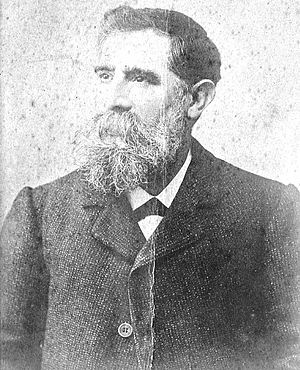Tomás Bretón facts for kids
Quick facts for kids
Tomás Bretón
|
|
|---|---|
 |
|
| Born |
Tomás Bretón y Hernández
29 December 1850 Salamanca, Spain
|
| Died | 2 December 1923 (aged 72) Madrid, Spain
|
| Nationality | Spanish |
| Occupation | Composer |
Tomás Bretón y Hernández (born December 29, 1850 – died December 2, 1923) was a famous Spanish conductor and composer. He is best known for his beautiful music, especially his Spanish operas and zarzuelas. A zarzuela is a type of Spanish musical play that mixes singing and spoken dialogue.
Contents
Biography: Tomás Bretón's Life Story
Tomás Bretón was born in Salamanca, a city in Spain. He loved music from a young age. He studied music at the School of Fine Arts in his hometown. To earn money, he played music in small orchestras, theaters, and churches.
When he was 16, Tomás moved to Madrid. There, he played in orchestras for zarzuela theaters. He also continued his music studies at the Royal Conservatory. In 1872, he won first prize for composition at the Conservatory. He shared this award with another famous composer, Ruperto Chapi.
After working in small theaters for several years, Tomás received an important grant in 1882. This grant allowed him to study music in other European cities. He traveled to Rome, Milan, Vienna, and Paris between 1881 and 1884. During this time, he worked on bigger musical pieces. These included an oratorio called El Apocalipsis and an opera named Los amantes de Teruel. An oratorio is a large musical work for orchestra and voices, usually based on a religious story. An opera is a play where the words are sung instead of spoken.
The first performance of Los amantes de Teruel at the Teatro Real in Madrid made him very famous. It showed everyone he was a major Spanish opera composer.
Bretón was also a very active conductor. He led orchestras and helped them perform music. From 1885 to 1891, he was the main conductor for the Madrid Concert Society. He started a series of concerts that featured both Spanish and international music. In 1892, the famous guitarist Francisco Tárrega dedicated his piece Capricho Arabe to Bretón.
In 1901, Tomás Bretón became the director of the Conservatory of Madrid. He held this important job until he retired in 1921. He worked hard to make music teaching more modern and to connect the school with music from other countries. He passed away in Madrid when he was 72 years old.
Work: What Tomás Bretón Composed
Tomás Bretón became very well-known because of his zarzuela La verbena de la Paloma. This is one of the most famous Spanish zarzuelas ever. He also composed other successful works. These included his operas Los amantes de Teruel and La Dolores.
Bretón wrote a lot of music during his life. He was a Conservatory Director and a respected orchestra conductor. He composed operas, zarzuelas, and music for orchestras and small groups (chamber music). He wanted to create a unique Spanish style of opera.
Opera: Spanish Stories in Song
Tomás Bretón wanted to create a truly Spanish opera. He wrote about these ideas and also composed many operas. He wrote nine operas in total. Two of them were short, with only one act. This was a lot of work for a Spanish composer at that time.
His opera Los amantes de Teruel (1889) was a big success. It helped him become a leading opera composer. He also wrote Garín (1892) and La Dolores (1894). His later operas include Raquel (1900) and Tabaré (1913).
Zarzuela: Musical Plays for Everyone
Bretón also wrote many zarzuelas. While he didn't write as many as some other composers, his zarzuelas were very good. He tried different styles within the zarzuela genre.
His most famous zarzuela is La verbena de la Paloma (1894). It's one of the most popular Spanish musical plays. He wrote many other zarzuelas too, but none became as famous as La verbena de la Paloma.
Orchestral Music: Grand Sounds
Tomás Bretón also wrote a lot of music for orchestras. This was special because at that time, there weren't many orchestras in Spain. He composed and conducted many pieces for the Sociedad de Conciertos. He was their chief conductor from 1885 to 1890.
He wrote three symphonies (1872, 1883, 1905). These showed that he was influenced by the great composer Beethoven. His most popular orchestral works had a Spanish feel. Examples include En la Alhambra (1887) and Escenas andaluzas (1894).
In his later years, he composed symphonic poems. These are orchestral pieces that tell a story or describe a scene. Examples are Los galeotes (1905), based on a story from Don Quixote, and Salamanca (1916), using folk tunes from his home region. He also wrote chamber music, like quartets, a trio, and a quintet. These were written in a classical style, influenced by French composers like Saint-Saëns.
Selected Works
Here are some of the important works Tomás Bretón composed:
- Symphony No. 1 in F major (1873)
- Guzmán el bueno, opera (1876)
- El campanero de Begoña, zarzuela (1878)
- Los amores de un príncipe, zarzuela (1881)
- El Apocalipsis, oratorio (1882)
- Symphony No. 2 in E flat Major (1883)
- Piano Trio in E Minor (1887)
- En la Alhambra, symphonic serenade (1887)
- Las golondrinas, song cycle (1887)
- Los amantes de Teruel, opera (1889)
- Garín, opera (1892)
- Escenas andaluzas, orchestral suite (1894)
- La Dolores, opera (1894)
- La verbena de la Paloma, zarzuela (1894)
- Raquel, opera (1900)
- El clavel rojo, zarzuela (1899)
- Covadonga, zarzuela (1901)
- Symphony No. 3 in G major (1905)
- Los galeotes, symphonic poem (1905)
- Violin Concerto in A minor (1909)
- Tabaré, Opera (1913)
- Don Gil de las calzas verdes, opera (1914)
- Salamanca, symphonic poem (1916)
Images for kids
See also
 In Spanish: Tomás Bretón para niños
In Spanish: Tomás Bretón para niños


